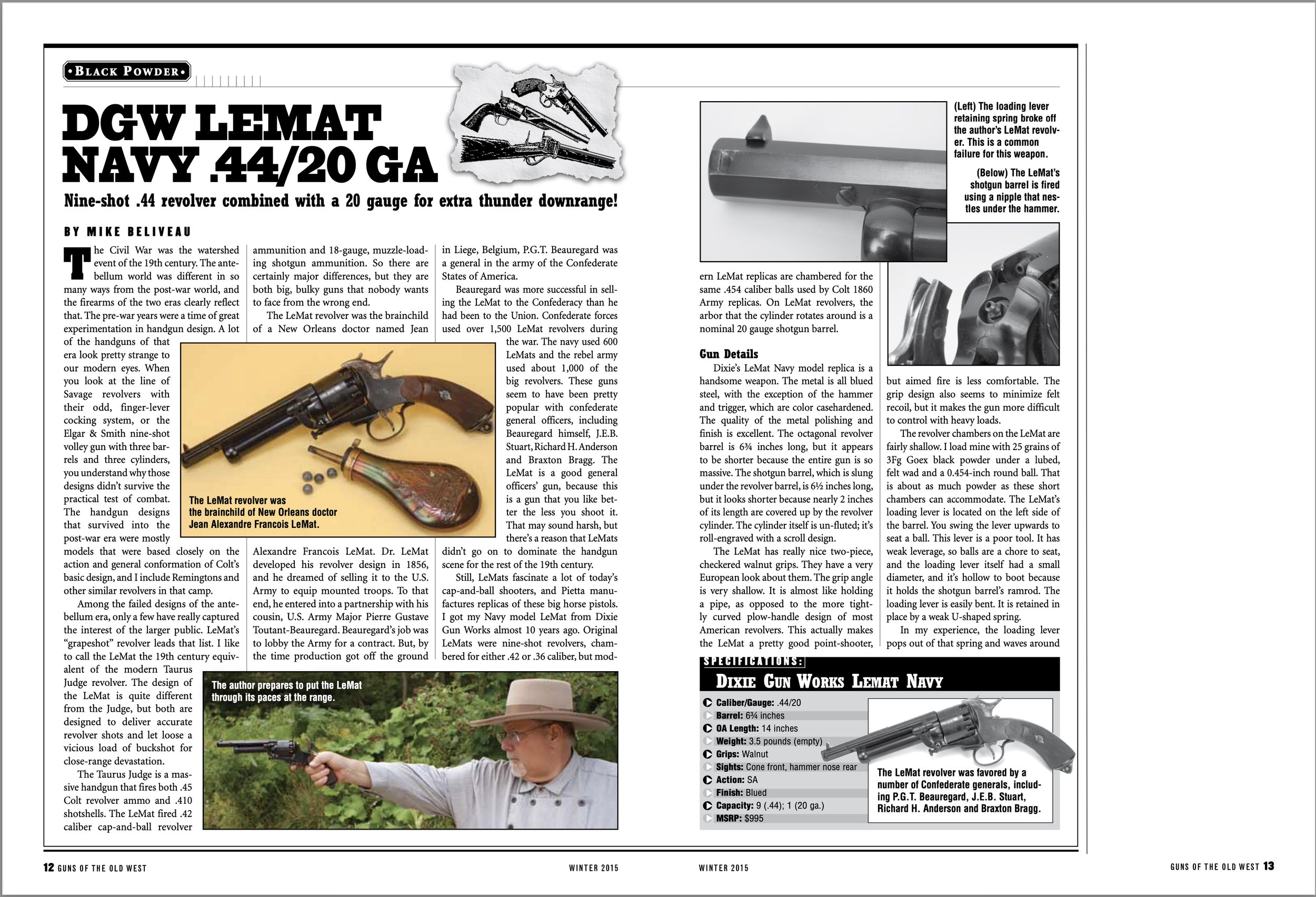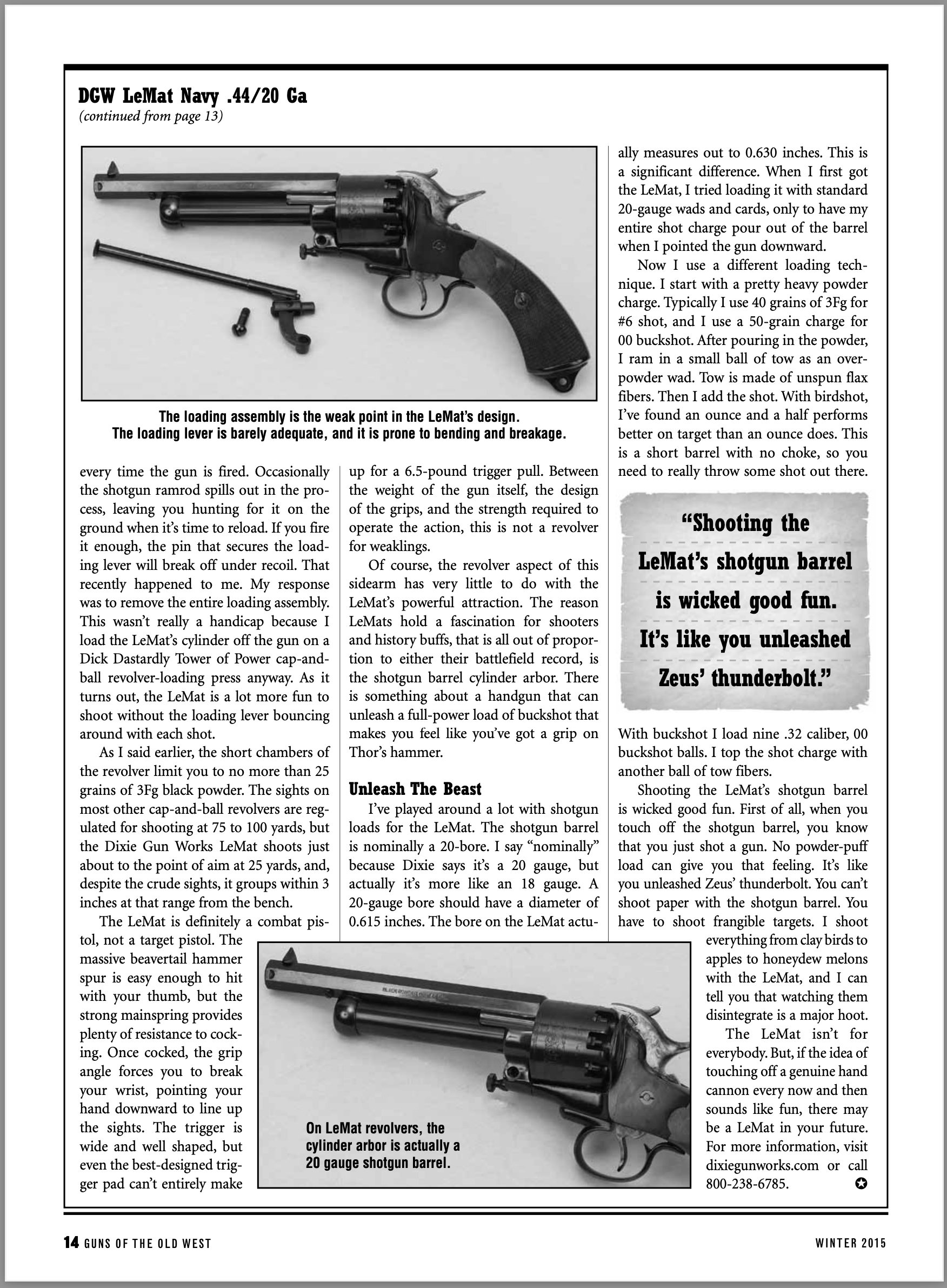DGW LeMat Navy .44/20 GA
Nine-shot .44 revolver combined with a 20 gauge for extra thunder downrange!
The Civil War was the watershed event of the nineteenth century. The antebellum world was different in so many ways from the post-war world, and the firearms of the two eras clearly reflect that. The pre-war years were a time of great experimentation in handgun design. A lot of the handguns of that era look pretty strange to our modern eyes. When you look at the line of Savage revolvers with their odd, finger-lever cocking system, or the Elgar & Smith nine-shot volley gun with three barrels, and three, three-chambered cylinders, you understand why those designs didn’t survive the practical test of combat. The handgun designs that survived into the post war era were mostly models that were based closely on the action and general conformation of Colt’s basic design, and I include Remingtons, and other similar revolvers, in that camp.
Among the failed designs of the antebellum era, only a few have really captured the interest of the larger public. LeMat’s Grapeshot revolver leads that list. I like to call the LeMat the nineteenth century equivalent of the modern Taurus Judge revolver. The design of the LeMat is quite different from the Judge, but both are designed to deliver accurate revolver shots coupled with the ability to let loose a vicious load of buckshot for close range devastation.
The Taurus Judge is a massive handgun that fires both .45 Colt revolver ammo and .410 shotshells. The LeMat fired .42-caliber cap and ball revolver ammunition, and 18-gauge muzzleloading shotgun ammunition. So there are certainly major differences, but they are both big, bulky guns that nobody wants to be face from the wrong end.
The LeMat revolver was the brainchild of a New Orleans doctor named Jean Alexandre Francois LeMat. Dr. LeMat developed his revolver design in 1856, and he dreamed of selling it to the U.S. Army to equip mounted troops. To that end he entered into a partnership with his cousin, U.S. army Major Pierre Gustave Toutant-Beauregard. Beauregard’s job was to lobby the Army for a contract. But, by the time production got off the ground in Liege, Belgium, P. G T. Beauregard was a general in the Army of the Confederate States of America.
Beauregard was more successful in selling the LeMat to the Confederacy than he had been to the Union. Confederate forces used over 1,500 LeMat revolvers during the war. The navy used 600 LeMats and the rebel army used about 1,000 of the big revolvers. These guns seem to have been pretty popular with confederate general officers. Besides Beauregard, generals J.E.B. Stuart, Richard H. Anderson, and Braxton Bragg. The LeMat is a good general officers’ gun, because this is a gun that you like better the less you shoot it. That may sound harsh, but there’s a reason that LeMats didn’t go on to dominate the handgun scene for the rest of the nineteenth century.
Still, LeMats fascinate a lot of today’s cap and ball shooters, and Pietta manufactures replicas of these big horse pistols. I got my Navy model LeMat from Dixie Gun Works almost 10 years ago. Original LeMats were nine-shot revolvers, chambered for either .42 caliber or .36 caliber, but modern LeMat replicas are chambered for the same .454 caliber balls used by 1860 Colt Army replicas. On LeMat revolvers the arbor that the cylinder rotates around is a nominal 20-gauge shotgun barrel.
Dixie’s LeMat replica is a handsome weapon. The metal is all blued steel, with the exception of the hammer and trigger, which are color case hardened. The quality of the metal polishing and finish is excellent. The octagon revolver barrel is seven inches long, but it appears to be shorter because the entire gun is so massive. The shotgun barrel, which is slung under the revolver barrel is six and a half inches long, but it looks shorter because nearly two inches of its length are covered up by the revolver cylinder. The cylinder itself is un-fluted and it is roll-engraved with a scroll design.
My LeMat’s grips are really nice two-piece, checkered walnut. They have a very European look about them. The grip angle is very shallow. It is almost like holding a pipe, as opposed to the more tightly curved plow handle design of most American revolvers. This actually makes the LeMat a pretty good point shooter, but aimed fire is less comfortable. The grip design also seems to minimize felt recoil, but it makes the gun more difficult to control with heavy loads.
The revolver chambers on the LeMat are fairly shallow. I load mine with 25 grains of 3Fg Goex black powder under a lubed, felt wad and a .454-inch round ball. That is about as much powder as these short chambers can accommodate. The LeMat’s loading lever is located on the left side of the barrel. You swing the lever upwards to seat a ball. This lever is a poor tool. It has weak leverage, so balls are a chore to seat, and the loading lever itself had a small diameter, and it is hollow to boot because it holds the shotgun barrel’s ramrod. The loading lever is easily bent. It is retained in place by a weak “U” shaped spring.
In my experience the loading lever pops out of that spring and waves around every time the gun is fired. Occasionally the shotgun ramrod spills out in the process, leaving you hunting for it on the ground when it’s time to reload. If you fire it enough, loading lever-securing spring will break off under recoil. That recently happened to me. My response was to remove the entire loading assembly. This wasn’t really a handicap because I load the LeMat’s cylinder off the gun on a Dick Dastardly Tower of Power cap and ball revolver loading press anyway. As it turns out, the LeMat is a lot more fun to shoot without the loading lever bouncing around with each shot.
As I said earlier, the short chambers of the revolver limit you to no more than 25 grains of 3Fg black powder. The sights on most other cap and ball revolvers are regulated for shooting at 75 to 100 yards, but the Dixie Gun Works LeMat shoots just about to the point of aim ay 25 yards, and, despite the crude sights, it groups within three inches at that range from the bench.
The LeMat is definitely a combat pistol, not a target pistol. The massive, beavertail hammer spur is easy enough to hit with your thumb, but the strong main spring provides plenty of resistance to cocking. Once cocked, the grip angle forces you to break your wrist, pointing your hand downward to line up the sights. The trigger is wide and well shaped, but even the best-designed trigger pad can’t entirely make up for a six and a half pound trigger pull. Between the weight of the gun itself, the design of the grips, and the strength required to operate the action, this is not a revolver for weaklings.
Of course the revolver aspect of this sidearm has very little to do with the LeMat’s powerful attraction. The reason LeMats hold a fascination for shooters and history buffs, that is all out of proportion to either their battlefield record, is the shotgun barrel cylinder arbor. There is something about a handgun that can unleash a full-power load of buckshot that makes you feel like you’ve got a grip on Thor’s hammer.
I’ve played around a lot with shotgun loads for the LeMat. The shotgun barrel is nominally a 20-bore. I say nominally because Dixie says it’s a 20 gauge, but actually it’s more like an 18 gauge. A 20-gauge bore should have a diameter of 0.615-inches. The Bore on the LeMat actually measures out to 0.630-inches. This is a significant difference. When I first got the LeMat, I tried loading it with standard 20-gauge wads and cards, only to have my entire shot charge pour out of the barrel when I pointed the gun down.
Now I use a different loading technique. I start with a pretty heavy powder charge. Typically I use 40 grains of 3Fg for number 6 shot, and I use a 50-grain charge for 00 buckshot. After pouring in the powder, I ram in a small ball of tow as an over powder wad. Tow is made of unspun flax fibers. Then I add the shot. With birdshot, I’ve found an ounce and a half performs better on target than an ounce does. This is a short barrel, with no choke, so you need to really throw some shot out there. With buckshot I load nine .32 caliber, 00 buckshot balls. I top the shot charge with another ball of tow fibers.
Shooting the LeMat’s shotgun barrel is wicked good fun. First of all, when you touch off the shotgun barrel, you know that you just shot a gun. No mouse fart load can give you that feeling. It’s like you unleashed Zeus’ thunderbolt. You can’t shoot paper with the shotgun barrel. You have to shoot frangible targets. I shoot everything from clay birds to apples to honeydew melons with the LeMat, and I can tell you that watching them disintegrate is a major hoot.
The LeMat isn’t for everybody. But, if the idea of touching off a genuine hand cannon every now and then sounds like fun, there may be a LeMat in your future.
Specification:
Dixie Gunworks Army model LeMat revolver
Caliber: .44 (revolver), 20 ga shotgun
Barrel: 6.75 inches
OA Length: 14 inches
Weight: 3 pounds 8 ounces
Capacity: 9 rounds (revolver), 1 round (shotgun)
Sights: Large cone front sight, hammer nose rear sight
Finish: Blued steel
Action: Single action revolver, single shot shotgun
Stocks: Two-piece, checkered walnut
Point of contact:
Dixie Gun Works Inc.
1412 West Reelfoot Ave.
Union City, TN 38218
800-238-6785

